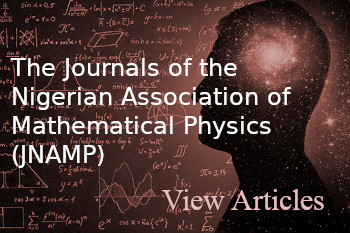COMPARATIVE APPROACH FOR INCREMENTAL OIL DETERMINATION: IMPLEMENTING TRAPEZOIDAL RULE AND CUBIC SPLINE MODELS
Keywords:
Enhanced Oil Recovery, Incremental Oil Recovery, Polymer Flooding, Surfactant Flooding, Trapezoidal Rule Model, Cubic Spline ModelAbstract
Different approach have been applied to estimate the incremental oil recovered in enhanced oil recovery (EOR) flow systems and these models have challenges and limitations in surfactant and polymer flooding methods in EOR incremental oil determination. Two methods of incremental oil determination were applied in this research: cubic spline and trapezoidal rule models. Cubic spline model involves the formulation numerical model for the surfactant and polymer flooding in the determination of incremental oil from EOR flow system application. To achieve this, experimental data for the surfactant and polymer flooding were introduced into the model formulated. Also, trapezoidal rule model was applied to the surfactant and polymer flooding systems to determine incremental oil from EOR flow system. Performance increase in the incremental oil was recorded in the application of cubic spline compared to trapezoidal rule in the surfactant and polymer flooding EOR flow system. The performance differences between cubic spline and trapezoidal rule are due to the errors of approximation associated with the linearity of the function obtained from the trapezoidal rule. The straight line approximation from the trapezoidal rule introduce errors because the actual nature of the line is not a straight line, but a curve and is best represented by a cubic spline, making the cubic spline model to perform better than the trapezoidal rule model in the surfactant and polymer flooding systems.The polymer flooding act as a better sweeping agent than surfactant flooding in EOR
system and this determine the incremental oil recovered at the effluents.
Downloads
References
Larry, W. L. (1989). “Enhanced Oil Recovery”, A Book Published by Prentice-Hall, Inc. A Pearson Education Company, Upper Saddle River, NJ 07458, USA.
Green, D. W. and Willhite, G. P. (1998). “Enhanced Oil Recovery” Henry L. Doherty Memorial Fund of AIME, Society of Petroleum Engineers, Richardson, Texas, SPE Textbook Series Vol. 6
Prats, M. (1982). “Thermal Recovery”, Dallas: Society of Petroleum Engineers of American Institute of Mining and Metallurgical Engineers, Henry L. Doherty Series, Monograph 7
Campbell, J. M. (1965). "Oil Property Evaluation: A Practical Guide to the Evaluation of Oil Properties", A Book Published by Englewood Cliffs, Prentice-Hall, Inc.
Thuesen, H.G. (1950). "Engineering Economy, First Edition”, A Book Published by Prentice-Hall, Inc., Englewood Cliffs, New York, NY, USA.
Tayfun, B. (2007), “Development of Mature Oil Fields – A Review”. Science Direct, Journal of Petroleu Science and Engineering, Volume 57, Issues 3-4, Pages 221-246. ISSN 0920-4105 https://doi.org/10.1016/j.petrol.2006.10.006
Onyekonwu, M. O. and Ogolo, N. A., (2010), “Investigating the Use of Nanoparticles in Enhanced Oil Recovery”, Paper SPE 140744 presented at the Nigeria Annual International Conference and Exhibition, Society of Petroleum Engineers, 31st July-7th August, Tinapa, Calabar, Nigeria.
Suleimanov, B. A., Ismailov, F. S. and Veliyev, E. F., (2011), “Nanofluid for Enhanced Oil Recovery”, Journal of Petroleum Science and Engineering, 78, 431-437.
Green, D. W. and Willhite, P. (2003), “Enhanced Oil Recovery”, Second Edition, SPE, Texas.
Otamere and Igbinere Trans. Of NAMP Kalkarni, M. M. and Rao, D. N. (2005), “Experimental Investigation of Miscible and Immiscible Water-
Alternating-Gas (WAG) Process Performance”. Journal of Petroleum Science and Engineering, 48, pp. 1-20
Abbas, M. and Olafuyi, O. (2015), “Application of Cubic Spline Numerical Modeling on Displacement Mechanism”. Journal of Petroleum & Coal, 57 (3), pp. 225-233. ISSN 1337-7027
Steven, C. C. and Raymond P. C. (2010). “Numerical Methods for Engineers, Sixth Edition,” A Book Published by McGraw-Hill Higher Education, McGraw-Hill Companies Inc., 1221 Avenue of the Americas, New York, NY 10020
Jerome, F., Trevor, H. and Robert, T. (2001). "The Element of Statistical Learning, Basis Expansion and Regularization," Annals of Statistics, pp. 115-164.
Alan, J (2002). “Advanced Engineering Mathematics,” Published by Harcourt/Academic Press, A Harcourt Science and
Technology Company, 200 Wheeler Road, Burlington, Massachusetts 01803, USA. http://www.harcourt-ap.com
Jeffery, R. C. (2012). “Introduction to Numerical Methods,” Creative Commons Attribution 3.0 Hong Kong License University of Science and Technology, pp. 27-33
Richard, W. D. (1978). “Introduction to Numerical Methods and Optimization Techniques,” A Book by Thomond Books, A Division of Elsevier/North-Holland Scientific Publishers, Ltd, P. O. Box 85 Limerick, Ireland pp. 73-97
Autar, K. and Michael, K. (2012). “Spline Method of Interpolation: General Engineering,” A Textbook Notes on the Spline Method of Interpolation, pp. 1-12. http://numericalmethods.eng.usf.edu
Dukkipati, R. V. (2011). “Numerical Methods,” A Book Published by Ashan, Fair Field University, ISBN 10: 1848290543 ISBN 13: 9781848290549
Rathod, H.T., Shrivalli, H.Y., Nagaraja, K.V and Kesavulu N. (2010). "On a New Cubic Spline Interpolation with Application to Quadrature”, International Journal of Mathematical Analysis, Vol 4, No. 28, pp. 1387-1415 ISSN 1312-8876.

Downloads
Published
Issue
Section
License

This work is licensed under a Creative Commons Attribution-NonCommercial-ShareAlike 4.0 International License.




